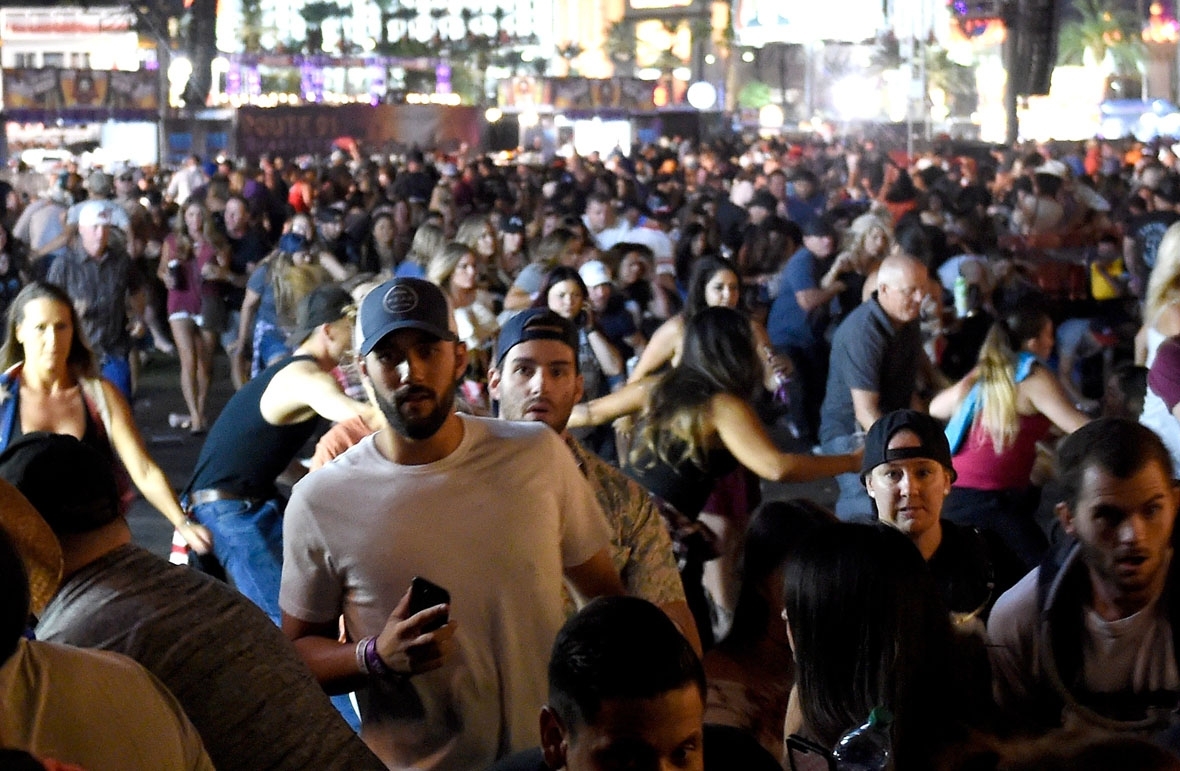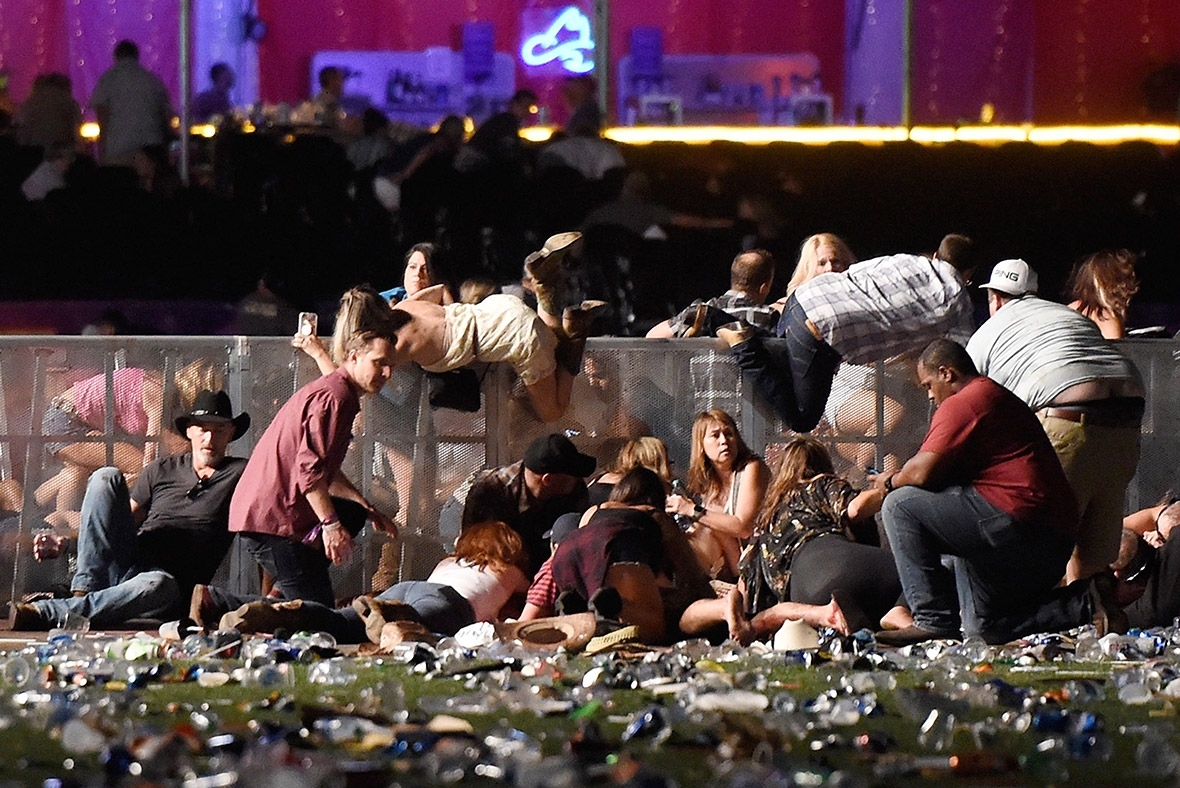Photographer captures scenes of mass shooting at country music festival near Mandalay Bay, Las Vegas
David Becker, a photojournalist covering the country music festival in Las Vegas for Getty Images, braved machine gun fire to take photos of the mass shooting.
David Becker, a photojournalist who was covering the Route 91 Harvest country music festival in Las Vegas for Getty Images, braved machine gun fire to take photos of the mass shooting. His photos show the initial panic after gunshots were heard, with people running and taking whatever minimal cover they could find. They also show several people lying on the ground after the mass shooting. He and fellow Getty photojournalist Ethan Miller then photographed the police operation to find the suspects.






















At least 50 people were shot dead and over 400 injured in a mass shooting at a concert on the Las Vegas Strip in Nevada. The death toll makes this the most deadly mass shooting in modern US history. It took place overnight on Sunday 1 October as hundreds of music fans gathered for the final night of a festival near the Mandalay Bay Hotel. The singer Jason Aldean had been performing when the shooting began. The musicians stopped and then restarted before cancelling the show when further gunfire was heard.
The shooter was killed by police on the 32nd floor of the Mandalay Bay Hotel which was overlooking the nearby music festival. The gunman, who has been named as 64-year-old Stephen Paddock, lived locally. Police were looking for his companion, Marilou Danley, 62, who remained at large at time of writing.
David Becker, the Getty Images photographer who took the photos of the carnage, tells the story of what he witnessed that night:
"After capturing photographs of the final act of the Route 91 Harvest country music festival, I headed back to the media tent to start filing my photographs. After about 5-10 minutes I heard very loud popping sounds and I went outside to see what was happening and a security guy said it was just "fire crackers", so I went back to work. The second time I heard the popping sounds somebody said to me "it was just speakers or sound equipment" and again, I went back into the media tent and continued to work. Then the noises went again and that was when the crowd started to flee.
"Once the crowd started to flee I went outside and saw a lot of people panicking and running for the exit that was right by the media tent. I grabbed my camera and went back outside and found a place where I could see what was happening and also wouldn't be in the way of people, so I stood on a table and started to shoot – thinking to myself still, that this isn't really happening, it's just the speakers popping. It was so dark I couldn't really see what was happening, there were a lot of people crying, speaking on cell phones and ducking for cover. As the crowd thinned out I was able to go a little closer to try and see what was going on and take some more pictures, and I'm still thinking to myself 'it's just the speakers, there is nothing going on'.
"There were groups of people helping each other everywhere and a real sense of people running for cover. People were fleeing, they were panicking. The gun fire was sporadic, it would stop and then more shots, then a lull and then more shots. I could hear people yelling at them to shut off the lights, to be quiet. People were cowering, they were very fearful for their lives. A woman tripped right in front of me, a man shielded a woman with his body before I saw them both get up and run away, a man in a wheelchair was helped to an exit. I was trying to capture anything that was moving and that had good lighting. That was critical, it was so dark and there was limited lighting it was really hard to get a sense of what was happening. At this stage I still just thought it was a speaker popping, so I was trying to capture people's emotions and a sense of the panic that was around me.
"I went back into the media tent and called my colleague to see if he could find out what was happening, as I still didn't know what was going on, and he said that he had found out that the police had called a Code Red and set up a perimeter. It was then I started looking at my photographs and what I was seeing was just unbelievable. It had been so dark outside I couldn't see the details, I just saw a lot of people laying on the ground thinking they were playing possum, but now I could see people covered in blood and I thought, this is real. When I saw the image of the woman lying on the ground covered in blood, that was when the impact of what I was experiencing hit; when I realised people were dying.
"I kept editing and filing my photographs, the power had been cut so I was working off the light of my laptop, until after 5-10 minutes everyone was evacuated and I was escorted to my car. I worked the rest of the night and into the morning capturing the police officers moving in and the wounded helping each other on the streets.
"When I stop and think, it's hard to comprehend what I witnessed. I was on autopilot, just doing my job capturing what was happening, which I think is important. Impactful images like these tell a story, they move people to think twice about doing anything like this, they move governments to change policies to prevent horrific acts like these happening again. I've been doing this work for many years and it is instinct to photograph first and ask questions later. It probably seems irrational to just walk out and take pictures of people running for cover, but that is second nature for a photojournalist."
© Copyright IBTimes 2025. All rights reserved.




















